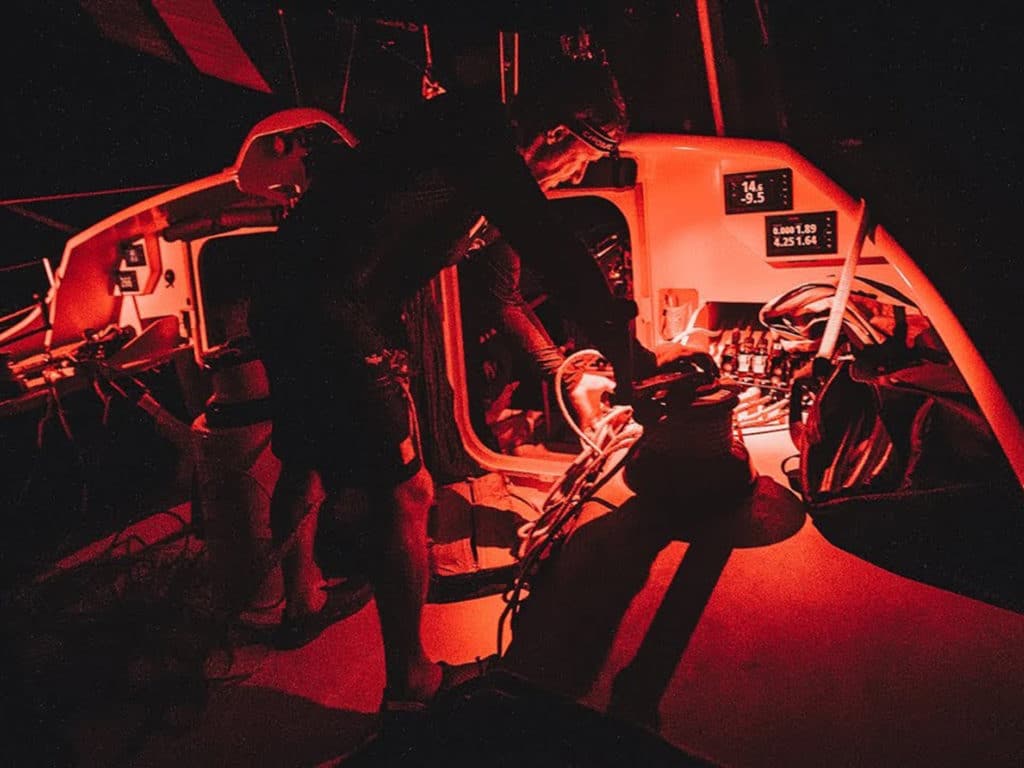
Imagine driving a top-down convertible along a twisting and unfamiliar road, through the blackness of a starless night. Then imagine the headlights blinking out. You can’t stop. The brakes are gone too. Your neurons are now firing, all your senses redlining as you steer into the darkness. Congratulations. You’re now a better driver.
That’s the idea, at least for the Long Island Sound-based youth squad, the Mudratz, which will soon start a night-sailing program for its more experienced kids. They’ll become better “night fighters,” says proud Mudratz parent Brandon Flack. “The rule of offshore racing is to dust them at night. To be better when the sun goes down.”
On five Saturday evenings this fall, weather dependent, says Flack, pairs will be placed into modified Melges 20, to simulate a doublehanded Olympic offshore racing sailor’s experiences, with a focus nighttime safety, navigation, and open course racing.”
The after-dark program idea, says Flack, belongs to USMMA Sailing Foundation president Ralph Steitz. “We talked about it for less than five minutes, and that’s all it took.”
To depower the boat for doublehanded harbor sailing, the organization modified the sails, cutting down the mainsails and jibs. They then added running lights, jacklines, and very basic electronics. The plan is to start practice before sunset every day to allow the youth sailors to familiarize themselves with the course and boathandling before sunset and before “doing it with blindfolds on,” Flack says.
There’s no official handbook for how to conduct the night-racing practices, Flack admits, so they’ll be essentially writing it as they go, starting with safety and navigation, then on to speed in the dark, and finally a few races when the kids are ready for it.
To ensure the kids learn to a maintain a proper lookout, and to intuitively feel conditions and boatspeed changes, there will be no electronics to keep them on their polars. “We decided it was better to take it away so they could get a feel for it first,” Flack says. “The numbers will come later.”
September 15 is the first scheduled practice; the water is still warm across Long Island Sound, and they have a good hour of twilight practice using government marks. Then off into the night, with, perhaps, a few surprises later into the program.
Jack Derry, a teenaged Mudratz long-timer, grew up sailing on the family cruising boat and fondly recalls many a night sails with his old man. So, he’s comfortable in the dark. But the whole Melges 20 thing excites him, in a living-dangerously-sort-of-way.
“To be on a boat with only one other person, without a GPS, will be really cool,” he says. “I don’t have to do dead reckoning, like my parents had to, but it’s just cool to be able to feel the boat and know it’s going fast. That make me a better sailor.”
Until Mudratz after dark, Derry had never raced at night, but he appreciates how his senses are far more elevated as his daytime visibility slips away. Flack says Derry is a lot like many of the other kids attracted to the program. “They have mostly grown up sailing on bigger boats with their families and have a safer feel for being on the water, and that’s why Jack is confident in his abilities.”
The appeal to night racing is also the unique experiences that can only happen at night, on the open sea. “It was super cool to sail at night and see the bioluminescence,” says Flack’s daughter, Lilly, “and the stars…oh man. And I’m really looking forward to sailing a sport boat at night.”
They’ll be home early enough to get to their schoolwork, Flack assures. They’ll be wide-eyed, salty, and fueled by adrenaline, like a young, doublehanded marathon sailor should be.









